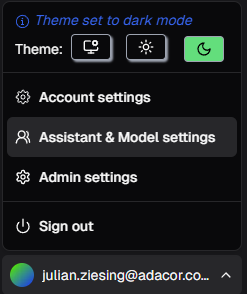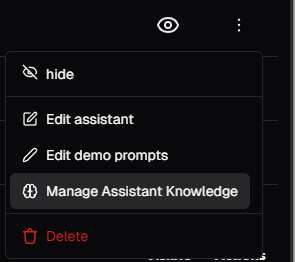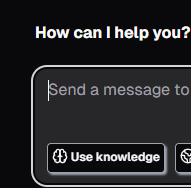Assistant Guide
How to create assistants that help you with recurring tasks and large knowledge
Assistants help you solve recurring tasks quickly and reliably.
In addition, you can equip them with documents that they can access when handling requests.
Distinction:
- Personal Assistants can only be seen by you.
- Company Assistants are available to all users in your company.
- Global Assistants are provided by the AI Workplace team to all users.
1. Where to find the Assistant Builder
In the AI Workplace, click your email address in the bottom left corner.
Open “Assistant & Model settings.”

Click “Add new Personal Assistant.” These assistants are only visible to you.
Alternatively, you can also create a company assistant: select “Company” on the left → “Add new Company Assistant.” These are visible to all company users.
Note: Documents uploaded to a Company Assistant are also accessible to all company users.
2. Creating assistants (most important fields & quick tips)
- Name: Internal name of the assistant (e.g., “HR Guide”).
- Label: Display name in the selection (e.g., “HR Assistant (Beta)”).
- Active state: Active = visible; Inactive = hidden (practical for setup).
- Description: 1–2 sentences describing the purpose (“Answers HR FAQs, links sources”).
- Model for text: Choose text model (if unsure, we recommend Mistral 3.2).
- Model for images: Choose image model (if unsure, we recommend Mistral 3.2).
- Behavior – short rules: Describe language and style, reference sources, ask follow-up questions if unclear.
- System message template: The starting prompt with multiple fixed fields to choose from.
- Welcome message: Greeting & first-step examples with which the assistant opens the conversation.
Click Save assistant.
3. Optional: Add documents (“knowledge”)
Documents you add to an assistant are available to it for all prompts where the user activates the “Use knowledge” button.
Example: A product manual in an assistant that should answer support questions about a product.
- Open Assistant & Model settings again.
- For the desired assistant, click ⋯ → Manage Assistant Knowledge.

- Select Add new Knowledge document and upload files.
- Max. 10 MB per document; split large files if necessary.
- Prefer searchable formats (PDF/Docx).
4. Activate & use assistants
- In chat, top left next to the logo, select the new assistant in the model drop-down.

- Send any chat message (e.g., “Go”) – this starts the assistant.
- Important: Click on Use knowledge to allow the assistant to access its documents.

Tip: Ask test questions and check if the results/tone/sources fit, and refine as needed. Usually, an iterative process is required for assistants to reach their full productivity.
5. Tips for knowledge (documents) in assistants
- More knowledge is not always better! Make sure you only embed relevant data that doesn’t distract.
- Assistants struggle with knowledge in the following cases:
- Abstract and open-ended questions. The clearer the correct answer can be found in the knowledge, the better.
- Questions whose answers are spread across multiple places/documents. Example: “List all our rules in our various company agreements that relate to families.” The LLM searches for the best matches—that is, the answers most likely to fit the question—and cannot reliably find all content that meets a criterion.
- Prompts that ask more than one question at a time. Example: “List all cars in our fleet that were purchased before 2020 AND had a new price over €50,000.” It’s better to proceed in multiple steps.
Overall tip: Start small, test, and improve. And when in doubt, it’s better to set up multiple assistants. This way, you can specialize each assistant for its task and upload only the necessary documents.
Further reading:
Updated 16 days ago